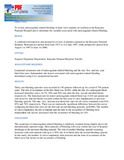| dc.description.abstract | OBJECTIVES:
To review anticoagulant-related bleeding in heart valve patients on warfarin at the Kenyatta National Hospital and to determine the variables associated with anticoagulant-related bleeding.
DESIGN:
A combined retrospective and prospective review of patients operated at the Kenyatta National Hospital. Retrospective period from June 1973 to 31st July 1997, while prospective period from August 1st 1997 to June 1st 2000.
SETTING:
Surgical Outpatient Department, Kenyatta National Hospital, Nairobi.
MAIN OUTCOME MEASURES:
Linearised occurrence rate of anticoagulant-related bleeding and the one- five- and ten- year bleed free rates. Independent risk factors associated with anticoagulant-related bleeding determined using Cox's proportional hazards.
RESULTS:
Thirty one bleeding episodes were recorded in 150 patients followed up for a total of 745 patient-years. The risk of occurrence of the first bleed was 16.0%; while the risk of a subsequent bleed increased thereafter with a 16.7%, 50% and 50% risk after the first, second and third bleeds respectively. The linearised rate for minor anticoagulant-related bleed was 4.16% per patient per year however, half the bleeds occurred within the first year of valve implantation or previous bleeding episode. The one-, five- and ten-year bleed free rates for all valves combined were 93%, 85% and 78% respectively. There was no statistically signicant difference between the curves comparing the bleed free rates for the first and second bleeding episodes (p=0.098). The number of valves implanted, the site of implant and the time to the occurrence of bleeding were independent risk factors associated with the occurrence of bleeding (p<.05).
CONCLUSION:
The occurrence of anticoagulant-related bleeding is relatively common being slightly above the internationally reported range. Most episodes of bleeding will occur within one year of hospital discharge or the previous bleeding episode. The risk of another bleeding episode occurring increases with each episode with up to a 50% risk of re-bleed after the second bleeding episode. In this study, the number of valves implanted, their position and the time of occurrence of the bleed were risk factors to the occurrence of bleeding. | en |

